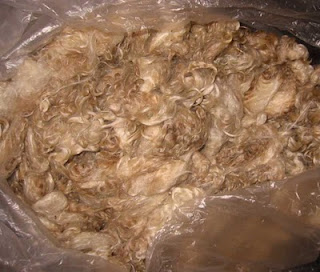I was recently asked how to deal with muddy tips in a fleece, and having been through a few fleeces, I had this advice:
My favorite "tough fleece" cleaner is Louet's FiberMaster [I bought lots of this; if you can't find any, Unicorn Power Scour is good, too]. I don't use it for just any fleece -- most fleeces come clean with either self-fermenting cleaning or a milder cleaner like Sodium Laurel Sulfate. SLS is the primary ingredient in cheap shampoo, and sold on its own in feed stores, in the horse aisles.
I had a particularly dirty/gummy Targhee fleece a few years ago, and FiberMaster didn't work, so I thought I'd step it up and try some Borax and detergent. Bad idea -- that combination was very pH basic, and it not only ate the finish off my new granite sink, it also broke the fleece. Lots of fluffy clean locks (it did clean it!) that now break when you tug on them. Sigh. The fleece now lives in my "what not to do" samples on fleece washing.
So now I am back to my older tricks for muddy tips, which include trying these, in order of difficulty/time involved:
If I need to get it done quickly, I'll try to pre-soak it overnight in tepid water and then use Louet FiberMaster to wash it. I've discussed this type of fleece washing before in "How do I wash raw fleece?"
If I have time, I will use the suint washing method, letting it sit in its own water for several days. I discussed this process on some fleeces before in "Slow Wool".
If neither of those work, I know I'm going to need to rewash the fleece, so I sample a couple of solutions:
1) put a few locks in a sink of hot soapy water, put on my extra-hot-water-protection gloves, and rub the tips while they are submerged. This usually works, but involves alot of under-water rubbing, which takes time, as each lock is rubbed on its own. When you keep them all submerged, and don't over-agitate, this is unlikely to cause matting.
2) once it's dry, pick open the fiber, with a wool picker. These are beasts, so you might ask around before you run out and buy one. Your guild or a fiber friend may have one you can try. This is usually pretty effective at opening up the tips after the first wash. Once it's all picked open, I will re-pick any that didn't open, or flick-card them open if there aren't too many, and rewash the fleece to get out that now-accessible dirt.
3) once it's dry, flick the dirty ends. This is time intensive as it, like the first, is done lock-by-lock. However, it will open the ends, and will also show you if the tips are weak. I often find that muddy tips are also weak tips. All that weather weakened their ability to shed the muck, and that seems correlated to their strength. Like the second method, you will need to re-wash the fleece after doing this, to remove the dirt that remains on the individual fibers.
Beth Smith (author of The Spinner's Book of Fleece, fiber artist, author and teacher) recently posted about fleece washing, she has some good tips on fleece washing (sorry for the pun!), and consistently gets good results: "Wool Scouring - Simple and Mostly Quick".
~~~~
© June 20, 2016 by Ask The Bellwether, posted at http://askthebellwether.com/





2 comments:
If the locks are long enough, would you ever consider snipping off the tips? If the tips are damaged, anyway, then it might save a lot of effort.
Trimming the tips is another possibility, yes; it's about as intensive an activity as flicking the tips, so I usually flick, but cutting off the tips would work as well, and may be a good choice if they are weathered and some are weakened.
Post a Comment